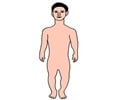- Hereditary Multiple Osteochondromas - (http://www.ncbi.nlm.nih.gov/books/nbk1235/)
- Multiple Hereditary Exostoses - General aspects - (http://www.mheresearchfoundation.org/tr_simgenetic_sec.html)
- Osteochondroma - (http://www.hopkinsmedicine.org/healthlibrary/conditions/bone_disorders/osteochondroma_85,p00125/)
What is Exostoses?
Multiple exostoses is a skeletal abnormality that is caused by genetic factors; this is why it is generally referred to as hereditary multiple exostoses. It is also known as multiple osteochondromas (which is preferred by the WHO) or diaphyseal aclasis. This genetic disorder causes abnormalities in bone growth and development with bony outgrowths, generally on the ends of long bones, but on other bones as well; these bony growths are called exostoses. The number of exostoses can also vary considerably among those affected. The exostoses are not found at birth. In most cases, children who suffer from the disorder will begin to develop exostoses by the time they have reached adolescence. The appearance and development of exostoses usually come to a halt by the time the affected individual reaches adulthood as the bones stop growing once a person has reached full height.
The condition is usually nonthreatening but can be very debilitating and in severe cases may also pose the risk of fatality, depending obviously on the location of the exostoses. Exostoses of the limbs can cause problems with mobility, gait and also result in short stature.
Causes of Exostoses
Multiple osteochondromas is caused by hereditary factors from genes we inherit from our parents. Genes, in simple terms, contain the code or instructions that guide cellular development, influencing our physical appearance as well as personality. Multiple exostoses is caused by a mutation or abnormality in the EXT1 or EXT2 gene.
- The condition, in most cases is inherited with the mutation being passed on from one of the parents. It may develop as a new mutation, although this is rare and occurs in just about 10 percent of all cases.
- The type of inheritance is autosomal dominant. Each of us receive two copies of every gene, one from our father and one from our mother. The mutation in this case is present in just one copy of the gene, but this is enough to cause the condition. Although the other of the two genes function completely normally, this will not prevent the development of hereditary multiple exostoses.
- The risk of passing the condition on to offspring during pregnancy is always present, with the risk being at 50 percent.
- If parents do not suffer from multiple exostoses but their offspring develops it, this does not increase the risk of their siblings developing multiple exostoses since the mutation has appeared de novo in the person.
Symptoms of Exostoses
Symptoms of multiple exostoses can vary among patients as the exostoses can develop and affect different bones in different individuals. The number of exostoses and the size of each exostoses can also vary. Generally, symptoms of multiple exostoses will include the following:
- Presence of a hard lump or mass that does not move and is painless.
- The affected child will most likely be shorter than other children of the same age.
- Muscles in the surrounding region will feel sore and strained.
- There may be abnormalities in growth such as one leg or arm being of a different length from the other.
- Joint pain and problems with mobility are not uncommon.
- Hip dysplasia because of abnormal bone development and bowing of the forearm or legs may also occur.

- These symptoms can at times severely restrict the range of movement and may even cause pain because of pressure on nerves, surrounding tissue and blood vessels.
In many cases there may also be no symptoms at all or they could closely resemble those of other common health conditions. Consult your health care provider for an accurate diagnosis.
These bony growths are benign and in most cases patients will not need to worry about the risk of cancer, but in rare cases they may turn malignant. The lifetime risk of such cancerous exostoses is estimated at being between 1 in 20, to 1 in 200.
Diagnosis of Exostoses
Hereditary multiple exostoses can be diagnosed before birth but it cannot be done with pregnancy ultrasounds as the exostoses usually does not begin to develop until well into childhood or adolescence. Prenatal diagnosis involves the following procedures:
- Testing a DNA sample taken from fetal cells obtained from the fluid surrounding the fetus in a procedure called amniocentesis. This is done after week 15 of the pregnancy.
- Chorionic villus sampling is another prenatal test that can be done and reveals chromosomal conditions. This test can be done between weeks 11 and 14 of the pregnancy.
These prenatal tests do pose some risks and are therefore only used when there is a high risk of genetic disorder, such as if one of the parents suffers from multiple exostoses or if an elder sibling is afflicted with the condition.
Before these tests are conducted, however, there are certain conditions that need to be met. Genetic testing will need to be conducted on the family member who suffers from multiple exostoses so that the gene with mutations can be identified.
If your child has already been born, doctors must be provided with a detailed medical history and will need to do a thorough physical examination. Diagnostic procedures that are used to detect multiple exostoses after birth can include the following:
- An x-ray is the most basic of all imaging tests and it can reveal some abnormalities in internal tissues, organs and, more importantly in this case, bones.
- A computed tomography scan or CT scan or magnetic resonance imaging (MRI) may also be used as these are more advanced imaging techniques that will provide your health care providers with more detailed images of the bones and other internal structures.

Treatment for Exostoses
There is no treatment that can prevent the occurrence of exostoses but treatment is aimed at providing relief from the symptoms as and when they appear. Treatment will depend on the age and general health of the patient, the extent of the disease, the location of the exostoses, and the patient’s tolerance to the required medications and procedures involved. Children with multiple exostoses can go on to lead fairly normal lives if they receive treatment promptly and have the support of their parents.
Treatment for exostoses involves:
- Surgical removal of the exostoses. This becomes necessary if the exostoses is large enough to cause bone deformity or if it exerts pressure on nerves or blood vessels.
- Administering of pain medications.
- Physical therapy to facilitate recovery and cope with complications from the condition.
Treatment of multiple exostoses doesn’t end with surgery and rehabilitative therapy however as there is still a risk of cancer, especially when the exostoses in adults is present in regions like the pelvis or scapula. Regular monitoring of the exostoses can help with early detection, improving the outcome of any treatment. Any sudden changes or growth spurts and increasing pain should immediately be reported to health care providers.

Health Tips
Ifeither parent suffers from multiple exostoses, the couple can seek geneticcounseling. A geneticist and genetic counselor will be able to help evaluatethe risk of offspring being affected with disease. They will also be able toconfirm a diagnosis and better inform the parents about all available treatmentoptions and the natural progression of the disease.







